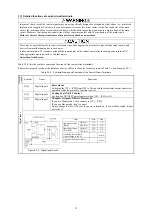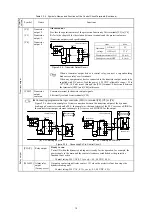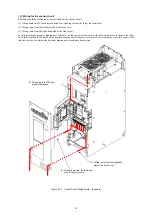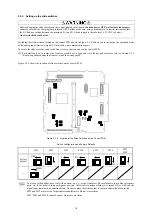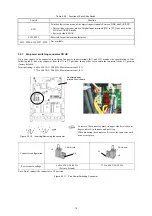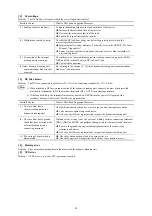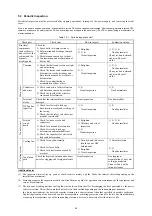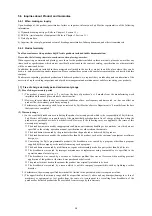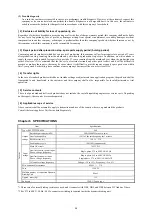
26
5.3 Periodic Inspection
Periodical inspection must be performed after stopping operations, turning off the power supply, and removing the front
cover.
Even if the power has been shut down, it takes the time for the DC link bus capacitor to discharge. After the charging lamp is turned OFF,
therefore, make sure for safety that the DC link bus voltage has dropped to the safe level (+25 VDC or below) using a multimeter or a
similar instrument.
Table 7.3-1 Periodic Inspection List 1
Check part
Check item
How to inspect
Evaluation criteria
Structural
components
such as chassis
and covers of the
cabinet and the
dynamic
breaking unit
Check for:
1) Loose bolts (at clamp sections).
2) Deformation and breakage (warped
cabinet)
3) Discoloration caused by overheat
4) Contamination and accumulation of
dust or dirt
1) Retighten.
2), 3), 4)
Visual
inspection
1), 2), 3), 4)
No
abnormalities
(If any section is stained,
clean it with a soft
cloth.)
Common
1) Check that bolts and screws are tight
and not missing.
2) Check the devices and insulators for
deformation, cracks, breakage and
discoloration caused by overheat or
deterioration.
3) Check for contamination or
accumulation of dust or dirt.
1) Retighten.
2), 3)
Visual
inspection
1), 2), 3)
No
abnormalities
(If any section is stained,
clean it with a soft
cloth.)
Conductors
and wires
1) Check conductors for discoloration
and distortion caused by overheat.
2) Check the sheath of the wires for
cracks and discoloration.
1), 2)
Visual
inspection
1), 2)
No
abnormalities
Terminal
blocks
Check that the terminal blocks are not
damaged.
Visual inspection
No abnormalities
Main c
ircui
t
DC link bus
capacitor
1) Check for electrolyte leakage,
discoloration, cracks and swelling of
the casing.
2) Check that the safety valve does not
protrude remarkably.
1), 2)
Visual
inspection
1), 2)
No
abnormalities
Control circu
it
Printed
circuit
board
1) Check for loose screws and
connectors.
2) Check for odor and discoloration.
3) Check for cracks, breakage,
deformation and remarkable rust.
4) Check the capacitors for electrolyte
leaks and deformation.
1) Retighten.
2) Olfactory and visual
inspection
3), 4)
Visual
inspection
1), 2), 3), 4)
No
abnormalities
Cooling fan 1) Check for any abnormality.
2) Check for loose bolts.
3) Check for discoloration caused by
overheat.
1) Turn by hand. (Be sure to
turn the power OFF
beforehand.)
2) Retighten.
3) Visual inspection
1) Smooth rotation
2), 3)
No
abnormalities
Cooling system
Ventilation
path
Check the heat sink, intake and exhaust
ports for clogging and foreign materials.
Visual inspection
No clogging or
accumulation of dust, dirt
or foreign materials.
Clean it, if any, with a
vacuum cleaner.
Additional notes
(1) The inspection interval (every year) of check items is merely a guide. Make the interval shorter depending on the
installation environment.
(2) Store and organize the inspection results to utilize them as a guide for operation and maintenance of the equipment and
service life estimation.
(3) The dynamic breaking unit has cooling fans inside to ventilate itself for discharging the heat generated by the power
converter section. This will accumulate dust or dirt on the heat sink depending on the surrounding environment.
In a dusty environment, the heat sink requires cleaning in a shorter interval than that specified in periodic inspection.
Neglecting cleaning of the heat sink can rise its temperature, activating protective circuits to lead to an abrupt shutdown
or causing the temperature rise of the surrounding electronic devices to adversely affect their service life.
Summary of Contents for BUC S-69D
Page 8: ......


